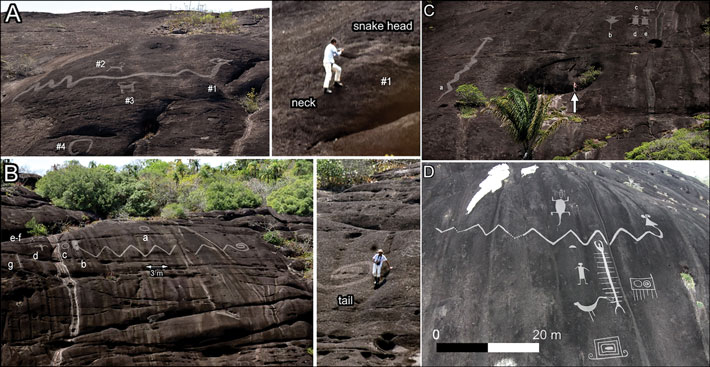 LONDON, ENGLAND—According to a statement released by Antiquity, a new study of rock engravings along the Atures Rapids on the Orinoco River in Colombia and Venezuela suggests that they may have been used to communicate territorial boundaries more than 2,000 years ago. Philip Riris of Bournemouth University and his colleagues worked with local guides to map artworks at 14 sites in the river basin with drone photography. Some of these rock art sites had been previously identified, but a few of them were discovered during the project. The images, including depictions of snakes measuring more than 130 feet long, resemble motifs on pottery uncovered in the area. “We know that anacondas and boas are associated with not just the creator deity of some of the Indigenous groups in the region, but that they are also seen as lethal beings that can kill people and large animals,” Riris said. Team member José Oliver of University College London noted that this stretch of the river was an important trade route and point of contact for local groups. The researchers suggest that the monumental artworks would have been highly visible. “Snakes are generally interpreted as quite threatening, so where the rock art is located could be a signal that these are places where you need to mind your manners,” Riris concluded. Read the original scholarly article about this research in Antiquity. To read about other rock art identified along the Atures Rapids, go to "World Roundup: Venezuela."
LONDON, ENGLAND—According to a statement released by Antiquity, a new study of rock engravings along the Atures Rapids on the Orinoco River in Colombia and Venezuela suggests that they may have been used to communicate territorial boundaries more than 2,000 years ago. Philip Riris of Bournemouth University and his colleagues worked with local guides to map artworks at 14 sites in the river basin with drone photography. Some of these rock art sites had been previously identified, but a few of them were discovered during the project. The images, including depictions of snakes measuring more than 130 feet long, resemble motifs on pottery uncovered in the area. “We know that anacondas and boas are associated with not just the creator deity of some of the Indigenous groups in the region, but that they are also seen as lethal beings that can kill people and large animals,” Riris said. Team member José Oliver of University College London noted that this stretch of the river was an important trade route and point of contact for local groups. The researchers suggest that the monumental artworks would have been highly visible. “Snakes are generally interpreted as quite threatening, so where the rock art is located could be a signal that these are places where you need to mind your manners,” Riris concluded. Read the original scholarly article about this research in Antiquity. To read about other rock art identified along the Atures Rapids, go to "World Roundup: Venezuela."
Rock Art May Have Marked Territory in South America
